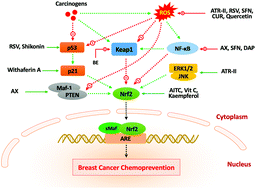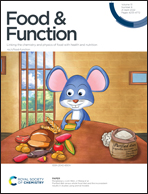Dietary phytochemicals targeting Nrf2 for chemoprevention in breast cancer
Abstract
Breast cancer accounts for 11.7% of all newly diagnosed cancer cases and has become the leading cause of cancer worldwide. Currently, more effective and less toxic chemopreventive strategies for breast cancer are urgently needed. Notably, naturally occurring dietary phytochemical compounds, such as curcumin and resveratrol, are generally considered to be the most promising breast cancer preventive agents. Nuclear factor erythroid 2-related factor 2 (Nrf2) is a transcription factor that plays a key regulatory role in the expression of multiple antioxidant and anti-inflammatory enzymes, which can effectively suppress the excessive accumulation of carcinogens and their metabolites. Therefore, modulation of Nrf2 by dietary phytochemicals appears to be a promising approach for breast cancer prevention, which further removes excessive carcinogenic metabolites by inducing Phase II cytoprotective enzymes such as heme oxygenase-1 (HO-1) and NAD(P)H quinine oxidoreductase 1 (NQO1). In this review, we summarize recently published findings on the prevention of breast cancer with potential natural phytochemical compounds targeting Nrf2, as well as a mechanistic discussion of Nrf2 activation and its contribution in inhibiting breast cancer carcinogenesis. The epigenetic regulation of Nrf2 by phytochemicals is also explored.

- This article is part of the themed collection: Food & Function Review Articles 2022


 Please wait while we load your content...
Please wait while we load your content...